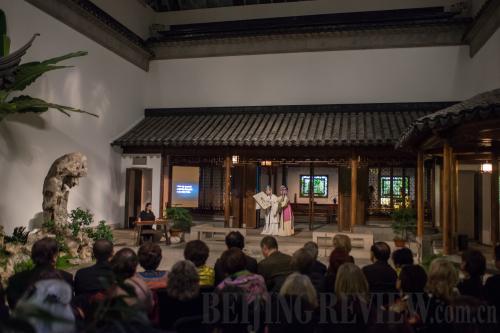|
 |
|
BIG APPLE OPERA: An American audience watches The Peony Pavilion at the Metropolitan Museum of Art in New York City on November 30 (STEPHANIE BERGER) |
For full coverage please click here
In a quiet garden in the middle of New York City, the sound of trickling water fills the air and the resounding call of a gong transports a small audience hundreds of years back in time to the Ming Dynasty (1368-1644). A zither and bamboo flute call to each other in a duet that tells the love story of classical China's great Kunqu Opera—The Peony Pavilion.
It was first performed in 1598—around the same time that Shakespeare penned his famous tale of the star-crossed lovers Romeo and Juliet. The Peony Pavilion tells a similar love story of Du Liniang and Liu Mengmei. The original version of the opera is performed over 20 hours and was traditionally staged in the gardens of wealthy landowners and royal families. Kunqu Opera is similar in style to Peking Opera, but is an older and more influential form.
The newest version, produced by celebrated Chinese composer Tan Dun and staged in a gallery at the Metropolitan Museum of Art in New York City (the Met) from November 30 to December 2, was aimed at bringing a modern interpretation to the classic, stripping out grand orchestration in favor of natural sounds of fountains and traditional Ming Dynasty instruments. The 70-minute abbreviated performance was held in front of an audience of just 50, seated diagonally in the garden courtyard on a makeshift stage. The performance was also filmed and streamed live to larger audiences and is available on the Met website.
Vocal calligraphy
It is Tan's fifth staging of the classic opera, which he calls a form of "voice calligraphy," but perhaps his most faithful. The garden setting is how original audiences would have enjoyed the opera. The Chinese garden on display at the Met is a near exact replica of a well-known garden in Suzhou, called The Garden of the Master of the Fishing Nets (Wangshi Garden). For the performance of The Peony Pavilion, Tan's production company imported many traditional elements and even 24 authentic Chinese goldfish, which did not adjust well to New York City water.
The result, said Tan, is that "outside has become in, and inside has become out." It's a concept that relates to the spirituality of what Chinese gardens represent. One visits a garden to soak in the outside natural world, and explore inner feelings and thoughts.
"The garden courtyard stage is as much a part of the performance as the music and costumes," said Tan. He draws his interpretation from two significant moments in his creative life, one of which was a magical moment of listening to bird songs and the sound of water and insects while sitting in a garden in China.
"A strong wind blew, very briefly, and when the sound of the birds and water came back it was so dramatic I thought to myself 'My god, this is opera,'" said Tan. "This is why they used to perform opera in the garden, instead of on a stage."
Kunqu's muse
The other inspiration for Tan's performance dates back to the first time he heard the traditional work, as a student at China's Central Conservatory of Music.
"I met a beautiful revolutionary opera singer once, her name is Yang Chunxia (an actress in modern revolutionary operas of the 1970s)," Tan said. "She sang The Peony Pavilion for me. I decided to be a composer from that day forward."
"The blending of traditional opera and instruments with modern sensibilities and technology is a hallmark touch of Tan's," said Maxwell K. Hearn, Director of Asia Department of the Met. Four cameras filmed the performance, and six strategically placed speakers surrounded the audience with the sounds of the original Suzhou garden thousands of miles away.
"[Tan] is an extraordinarily creative composer as well as conductor. He has really transformed world music by his amazing integration and blending of Western and Eastern traditional music, the blending of classical with contemporary musical form—all from a man who grew up in Hunan in a very provincial part of central China," said Hearn, "One of his earliest experiences in music was the shamanistic rituals he witnessed as a young boy in which the ceremonies involved using water and rocks and other natural objects to create a musical backdrop to those rituals."
Revitalization
In the 1980s, Tan studied at New York's Columbia University, where he became inspired by the experimental work of Phillip Glass and John Cage. He has staged and composed work for leading philharmonic orchestras around the world and won many awards, including an Oscar and a Grammy. He has also contributed many of China's most recognized modern musical works, including the film score for Crouching Tiger, Hidden Dragon and the themes for the award ceremonies of the Beijing Olympics.
| 